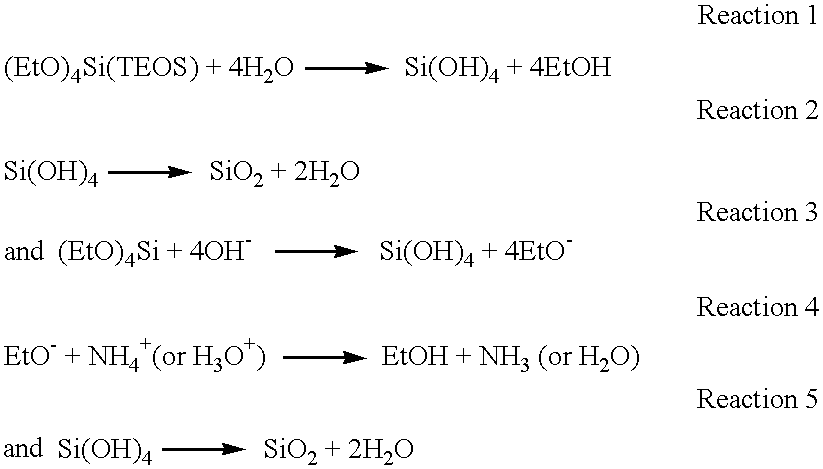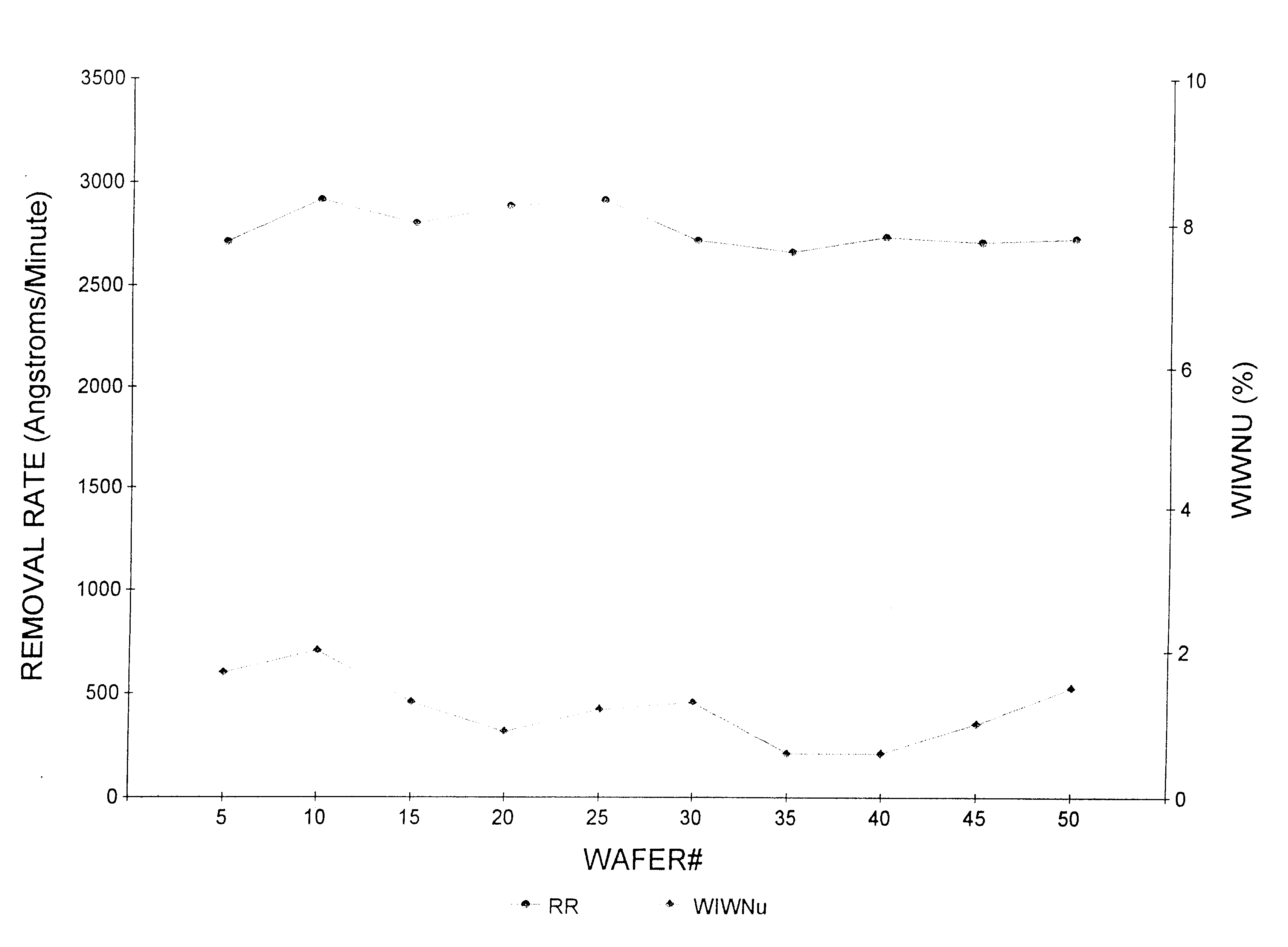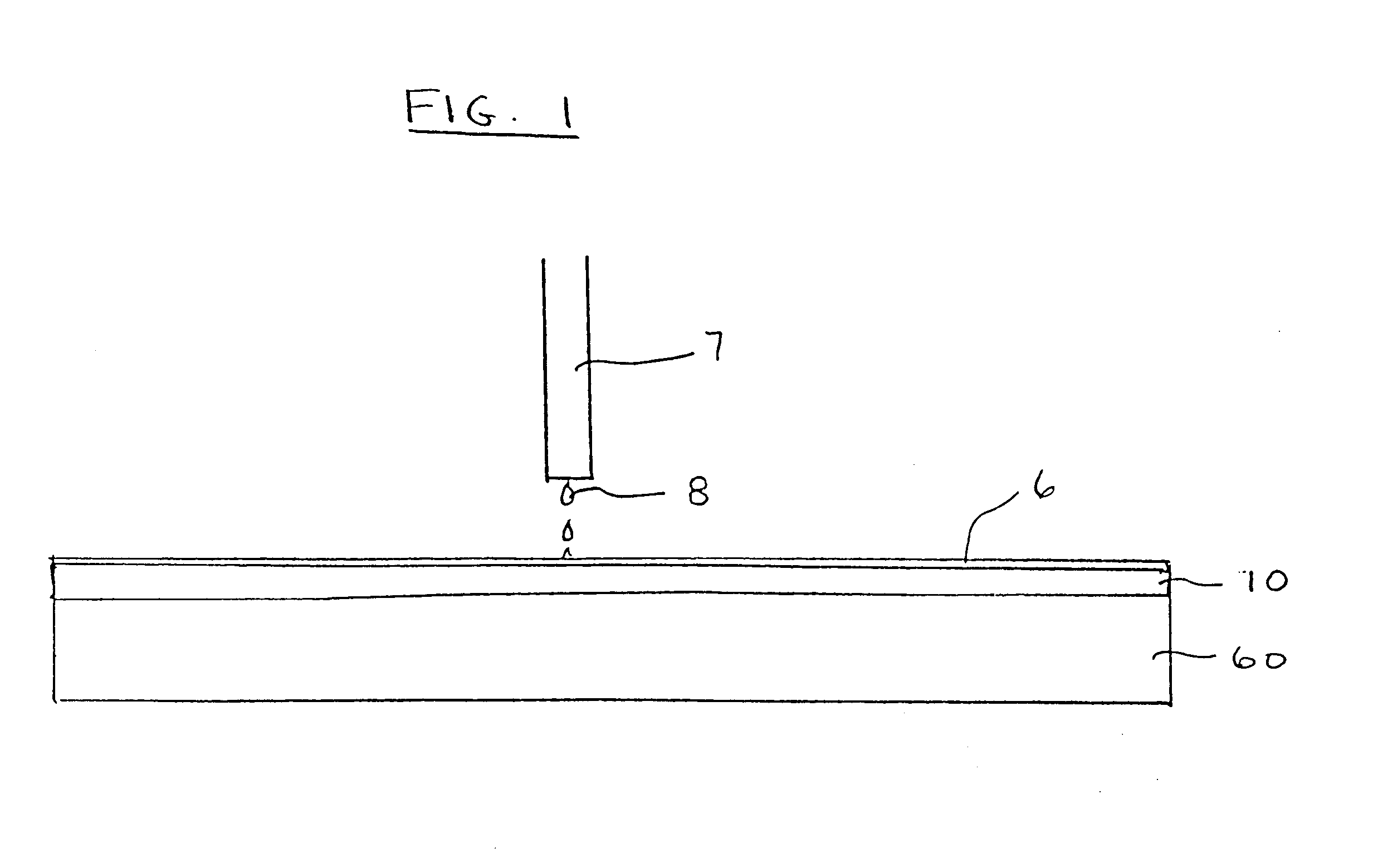Planarization compositions and methods for removing interlayer dielectric films
a technology of dielectric films and compositions, applied in the direction of polishing compositions, other chemical processes, manufacturing tools, etc., can solve the problems of unsuitable manufacture surface roughness, insufficient planarity of the resultant gap-filled surface, and large number of scratches on the planar surface. achieve the effect of improving the quality of planarization of dielectric films
- Summary
- Abstract
- Description
- Claims
- Application Information
AI Technical Summary
Benefits of technology
Problems solved by technology
Method used
Image
Examples
example 1
Method 1 for Manufacturing Ethyl Silicate Slurry
1. Materials
Solution A: 73 milliliters (ml) 28% ammonium hydroxide (NH.sub.4 OH; concentration: 2.07 mol / l) 41 ml water (H.sub.2 O; concentration: 26.94 mol / 1) 8 ml ethyl alcohol (ETOH; concentration: 0.16 mol / l)
Solution B: 46 ml TEOS; (final concentration: 1.92 mol / l).
2. Synthesis of Primary Particles
a. Warm a beaker to 33.degree. C. to 37.degree. C.
b. Add solutions A and B dropwise over 15 minutes, with constant stirring at 280 rpm into beaker with the flow rate of A twice the flow rate of B.
c. remove from heat, stir, cool to 21.5.degree. C. over 15 min.
3. Growth of Final Particles
a. Warm solution to 35.degree.-37.degree. C. while adding dropwise with stirring: 250 ml TEOS and 394 ml H.sub.2 O.
b. Stir for 1.0 hours in a closed vessel.
c. Add 30 mnl TEOS dropwise every 30 minutes for a total of 3 additions.
d. Particle size: 160-180 nm.
4. Final Slurry Composition (weight percent of total)
a. 12.95% silica (SiO.sub.2)
b. 2.0% NH.sub.3
c. 40...
example 2
Method 2 for Manufacturing Ethyl Silicate Slurry
1. Materials
a. Solution A: 123 ml of 28% NH.sub.4 OH; (concentration: 6.96 mol / l) 60 ml H.sub.2 O; (concentration: 19.78 mol / l) 10 ml ETOH; (concentration: 0.31 mol / l)
b. SolutionB: 24 ml 28% NH.sub.4 OH and 133 ml H.sub.2 O.
2. Synthesis of Primary Particles
a. Pre-warm beaker to 33.degree. C. to 37.degree. C.
b. Add Solution A to beaker dropwise over 30 minutes along with 77 ml TEOS with constant stirring at 280 rpm and flow rate of Solution A being twice the flow rate of TEOS (final TEOS concentration, 1.59 mol / l).
3. Growth of Final Particles
a. To the solution containing primary particles, add Solution B and 115 ml TEOS, both dropwise over 30 minutes, with constant stirring and with the flow rate of Solution B being twice that of the TEOS. After 2 / 3 of the TEOS has been added, the heat is turned off.
b. Stir for 1 hour more in a closed vessel.
example 3
Method 3 for Manufacturing Ethyl Silicate Slurry for CMP
1. Materials
a. Solution A: 147 ml NH.sub.4 OH, (concentration: 6.71 mol / l) 72 ml H.sub.2 O, (concentration: 19.38 mol / l) ml ETOH, (concentration: 0.36 mol / l)
b. SolutionB: 124 mlH.sub.2 O.
2. Synthesis of Primary Particles
a. Pre-warm beaker to 33.degree. C. to 37.degree. C.
b. Add Solution A and 92 mnl TEOS over 15 minutes, stir at 280 rpm with the flow rate of Solution A being twice the flow rate of the TEOS solution. (final TEOS concentration: 1.65 mol / l)
c. Let cool while stirring, over 15 minutes to 21.5.degree. C.
d. Particle size: 160-180 nm.
3. Growth of Final Particles
a. Warm the solution containing primary particles to 33.degree. C. to 37.degree.. Cover 30 minutes while adding Solution B and 115 ml TEOS, with the flow rate of Solution B being twice the flow rate of the TEOS. Reduce the heat after 1 / 3 of the TEOS has been added.
b. Stir in a closed vessel for 1 hour.
c. Particle size: 160-180 nm.
PUM
 Login to View More
Login to View More Abstract
Description
Claims
Application Information
 Login to View More
Login to View More - R&D
- Intellectual Property
- Life Sciences
- Materials
- Tech Scout
- Unparalleled Data Quality
- Higher Quality Content
- 60% Fewer Hallucinations
Browse by: Latest US Patents, China's latest patents, Technical Efficacy Thesaurus, Application Domain, Technology Topic, Popular Technical Reports.
© 2025 PatSnap. All rights reserved.Legal|Privacy policy|Modern Slavery Act Transparency Statement|Sitemap|About US| Contact US: help@patsnap.com



